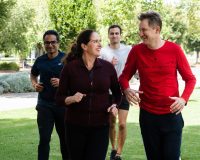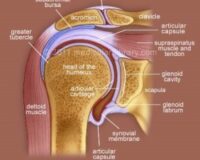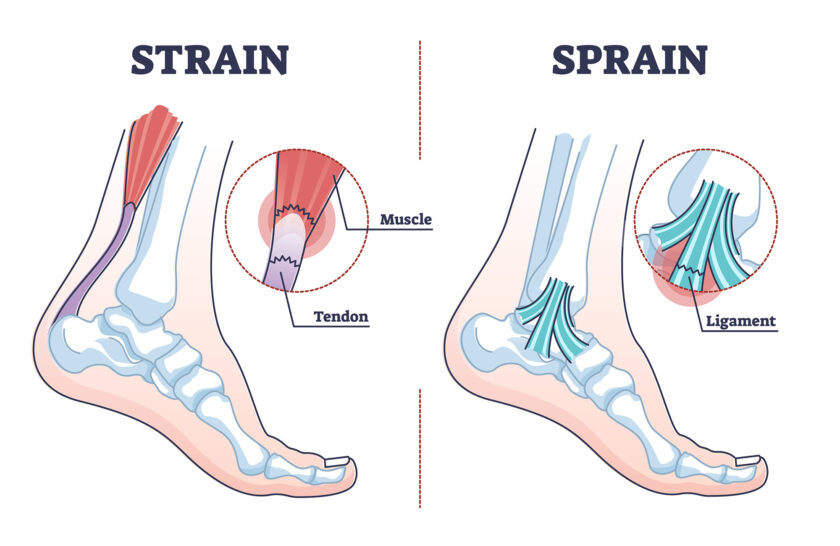
Sprains vs Strains
Slipped and rolled your ankle? Fell and used your arm to catch your fall? These are common reasons people can get a sprain or a strain. However, unless researched or told by a health professional many people can’t determine the severity of their injury; thus leaving it unattended in hopes it recovers with only rest. Strains and Sprains are very commonly confused with one-another. This because their symptoms are very similar.

What are they?
A sprain (Refer to Diagram 1) is the overstretching or tearing of LIGAMENTS. Ligaments are the bands of tissue that connect two bones together in a joint. The most common location for a sprain is the ankle joint.
A strain (Refer to Diagram 2) is the overstretching or tearing of MUSCLES OR TENDONS. Tendons are the dense fibrous cords of tissue that connect bones to muscles. The most common locations for a muscle strain are the hamstring muscles and the lower back.
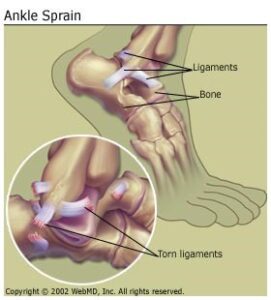
Diagram 1
What’s the difference?
Common symptoms of sprains
- Bruising
- Pain around the affected joint
- Swelling
- Limited flexibility
- Difficulty using the joint’s full range of motion
Common symptoms of strains
- Muscle spasm
- Pain around the affected joint
- Swelling
- Limited flexibility
- Difficulty using the joint’s full range of motion
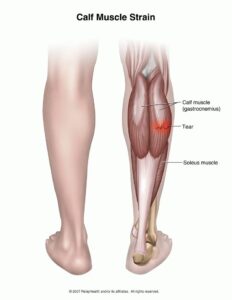
Diagram 2
Anything else I should know?
There are three degrees of sprains and regardless of the type you have its severity is determined using a three-degree scale.
(Ankle for example)
First degree:
Your ankle’s ligaments have stretched too far but have not torn. Symptoms may include:
- mild pain and swelling
- limited joint stiffness and instability
- uncomfortable jogging or jumping.
Second degree:
This is the most common type of sprain and results in a particular tear of the ligament.
- Lots of swelling and bruising
- Moderate pain
- Loss of motion or use of your ankle
- Difficulty walking
Third degree:
In the most severe type of sprain, the ligament is completely torn. Symptoms are:
- Severe swelling and pain
- Instability of the joint
- Extreme loss of motion
- Significant pain when moving/walking
After being assessed by a health professional, first and second degrees can be treated conservatively (at home) using PRICE (Protection, Rest, Ice, Compression and Elevation).
How we can help:
Seeing our practitioners like Remedial Massage Therapist will greatly benefit your recovery as they can create and execute a treatment plan that will address the acute stage of your specific injury as well as long-term recovery goals. The rehabilitation process also includes education and suggestions to prevent recurrent and future injuries.
Remedial massage can stimulate the blood supply, make joints more mobile, and help to repair damaged tissues. The therapist will aim to balance the length, tone and tension of muscles and tendons, which restores the correct position of the bones, increases blood flow and helps heal injuries.
Many people leave injuries unattended and this can make it worse and harder to recover from. Please get assessed by a health professional if you have any of these symptoms to ensure your own health and safety.
None of the information in this article is a replacement for proper medical advice. Always see a medical professional for advice on your injury.
To learn more about strains and sprains, book to see one of our Practitioners to get an assessment using the button below.
References:
https://www.healthdirect.gov.au/remedial-massage
https://www.emedicinehealth.com/muscle_strain/article_em.htm

